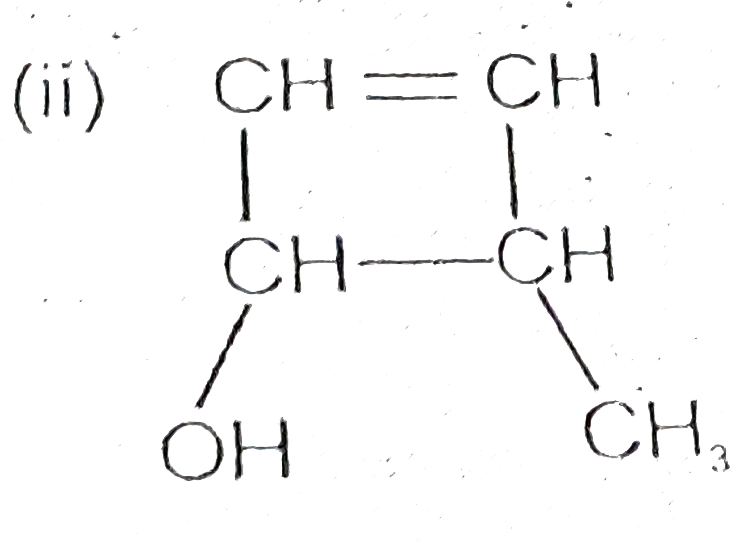Assertion (A): Following are the members of a homologous series CH3OH,CH3,CH2,OH,CH3,CH2,CH2OH
Reason (R): A series of compounds with same functional group but differing by-CH2, - unit is called a homologous series.
Both A and R are true and R is the correct explanation of A.
Both A and R are true but R is NOT the correct explanation of A.
A is true but R is false.
A is false and R is true.
The correct Answer is:A
Step-by-Step Solution:
1. Understanding the Assertion (A):
- The assertion states that the compounds CH₃OH, CH₃CH₂OH, and CH₃CH₂CH₂OH are members of a homologous series.
- A homologous series is a group of organic compounds that have the same functional group and differ from each other by a constant unit, typically −CH₂−.
2. Identifying the Functional Group:
- In the given compounds, the functional group is the −OH (hydroxyl) group, which indicates that these compounds are alcohols.
- The first compound CH₃OH is methanol, the second CH₃CH₂OH is ethanol, and the third CH₃CH₂CH₂OH is propanol.
3. Checking the Differences:
- To confirm they are part of a homologous series, we check the difference between successive members:
- From CH₃OH (methanol) to CH₃CH₂OH (ethanol), we add one −CH₂− unit.
- From CH₃CH₂OH (ethanol) to CH₃CH₂CH₂OH (propanol), we again add one −CH₂− unit.
- This confirms that the compounds differ by a −CH₂− unit.
4. Understanding the Reason (R):
- The reason states that a series of compounds with the same functional group but differing by −CH₂− units is called a homologous series.
- This definition aligns with the properties of the compounds listed in the assertion.
5. Conclusion:
- Both the assertion (A) and the reason (R) are true.
- The reason (R) correctly explains the assertion (A).
Final Answer: Both A and R are true, and R is the correct explanation of A.
---
- The assertion states that the compounds CH₃OH, CH₃CH₂OH, and CH₃CH₂CH₂OH are members of a homologous series.
- A homologous series is a group of organic compounds that have the same functional group and differ from each other by a constant unit, typically −CH₂−.
- In the given compounds, the functional group is the −OH (hydroxyl) group, which indicates that these compounds are alcohols.
- The first compound CH₃OH is methanol, the second CH₃CH₂OH is ethanol, and the third CH₃CH₂CH₂OH is propanol.
- To confirm they are part of a homologous series, we check the difference between successive members:
- From CH₃OH (methanol) to CH₃CH₂OH (ethanol), we add one −CH₂− unit.
- From CH₃CH₂OH (ethanol) to CH₃CH₂CH₂OH (propanol), we again add one −CH₂− unit.
- This confirms that the compounds differ by a −CH₂− unit.
- The reason states that a series of compounds with the same functional group but differing by −CH₂− units is called a homologous series.
- This definition aligns with the properties of the compounds listed in the assertion.
- Both the assertion (A) and the reason (R) are true.
- The reason (R) correctly explains the assertion (A).
Topper's Solved these Questions
- BOOK - OSWAL PUBLICATIONCHAPTER - CARBON COMPOUNDS EXERCISE - CASE-BASED MCQs15videos
CARBON COMPOUNDS
- BOOK - OSWAL PUBLICATIONCHAPTER - CARBON COMPOUNDS EXERCISE - SELF ASSESSMENT (OBJECTIVE TYPE QUESTIONS) A. Multiple Choice Questions3videos
CARBON COMPOUNDS
- BOOK - OSWAL PUBLICATIONCHAPTER - CARBON COMPOUNDS EXERCISE - BOARD CORNER ( Long Answer Type Questions)4videos
CARBON COMPOUNDS
- BOOK - OSWAL PUBLICATIONCHAPTER - CARBON AND ITS COMPOUNDSEXERCISE - CREATING BASED QUESTIONS23videos
CARBON AND ITS COMPOUNDS
- BOOK - OSWAL PUBLICATIONCHAPTER - CHEMICAL REACTIONSEXERCISE - BOARD CORNER (Short Answer Type Questions)3videos
CHEMICAL REACTIONS
Similar Questions
Knowledge Check
- Question 1 - Select One
CH3CH2CH2OH is a functional isomer of
AC2H5OCH3BCH3OC3H7CCH3CH2CH2OCH2CH3DCH3CHOHCH3 - Question 2 - Select One
CH3CHOOH−−−→CH3CH(OH)CH2CHO represents
ACannizaro' reactionBBenzoin' condensationCAldol condensationDPerkin' s reaction - Question 3 - Select One
CH3CH2C=NX−−→CH3CH2OH
The compound X isASnCl2/HCl/H2O, boilBH2/Pd−BaSO4CLiAlH4/etherDNaBH4/ether/H3O+
Give the names of the following compounds :
(i)CH3−CH2−CH2−CH(OH)−CH3
(ii) CH3−CH2−CH2−COOHView SolutionArrange the following compounds in increasing order of dipole moment :
CH3CH2CH3,CH3CH2OH,CH3CH2NH2View SolutionThe IUPAC name of CH3−CH(OH)−CH2−C(OH)(CH3)2 is :
View SolutionThe compound that reacts with NaOH .
(A)CH3OH
(B)CH3CH2OH
(C)C6H5OH
(D)C6H5CH2OHView SolutionConvert CH3OH into CH3CH2OH,CH3CH(OH)CH3 and (CH3)3COH. Only one type of reagent is permitted in each step.
View Solution


